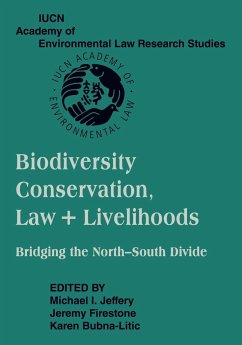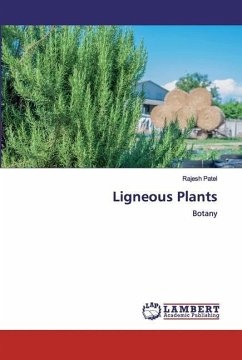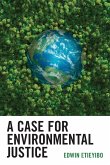Biodiversity Conservation, Law and Livelihoods
Bridging the North-South Divide: Iucn Academy of Environmental Law Research Studies
Herausgeber: Bubna-Litic, Karen; Jeffery, Michael I.; Firestone, Jeremy
Biodiversity Conservation, Law and Livelihoods
Bridging the North-South Divide: Iucn Academy of Environmental Law Research Studies
Herausgeber: Bubna-Litic, Karen; Jeffery, Michael I.; Firestone, Jeremy
- Broschiertes Buch
- Merkliste
- Auf die Merkliste
- Bewerten Bewerten
- Teilen
- Produkt teilen
- Produkterinnerung
- Produkterinnerung
This book presents a broad range of global perspectives on biodiversity conservation and the maintenance of sustainable cultures.
Andere Kunden interessierten sich auch für
![Ligneous Plants Ligneous Plants]() Rajesh PatelLigneous Plants46,99 €
Rajesh PatelLigneous Plants46,99 €![A Case for Environmental Justice A Case for Environmental Justice]() Edwin EtieyiboA Case for Environmental Justice43,99 €
Edwin EtieyiboA Case for Environmental Justice43,99 €![Law and Economics of Possession Law and Economics of Possession]() Law and Economics of Possession128,99 €
Law and Economics of Possession128,99 €![Security Rights in Movable Property in European Private Law Security Rights in Movable Property in European Private Law]() Michele Graziadei (Assist. ed.) / George L. Gretton / Cornelius G. van der Merwe / Matthias E. StormeSecurity Rights in Movable Property in European Private Law267,99 €
Michele Graziadei (Assist. ed.) / George L. Gretton / Cornelius G. van der Merwe / Matthias E. StormeSecurity Rights in Movable Property in European Private Law267,99 €![Housing Law and Policy Housing Law and Policy]() David CowanHousing Law and Policy181,99 €
David CowanHousing Law and Policy181,99 €![Security Rights in Movable Property in European Private Law Security Rights in Movable Property in European Private Law]() Security Rights in Movable Property in European Private Law87,99 €
Security Rights in Movable Property in European Private Law87,99 €![Law and Economics of Possession Law and Economics of Possession]() Law and Economics of Possession45,99 €
Law and Economics of Possession45,99 €-
-
-
This book presents a broad range of global perspectives on biodiversity conservation and the maintenance of sustainable cultures.
Hinweis: Dieser Artikel kann nur an eine deutsche Lieferadresse ausgeliefert werden.
Hinweis: Dieser Artikel kann nur an eine deutsche Lieferadresse ausgeliefert werden.
Produktdetails
- Produktdetails
- Verlag: Cambridge University Press
- Seitenzahl: 616
- Erscheinungstermin: 13. April 2012
- Englisch
- Abmessung: 254mm x 178mm x 33mm
- Gewicht: 1141g
- ISBN-13: 9781107404953
- ISBN-10: 1107404959
- Artikelnr.: 35893426
- Herstellerkennzeichnung
- Books on Demand GmbH
- In de Tarpen 42
- 22848 Norderstedt
- info@bod.de
- 040 53433511
- Verlag: Cambridge University Press
- Seitenzahl: 616
- Erscheinungstermin: 13. April 2012
- Englisch
- Abmessung: 254mm x 178mm x 33mm
- Gewicht: 1141g
- ISBN-13: 9781107404953
- ISBN-10: 1107404959
- Artikelnr.: 35893426
- Herstellerkennzeichnung
- Books on Demand GmbH
- In de Tarpen 42
- 22848 Norderstedt
- info@bod.de
- 040 53433511
Acknowledgments; Message from Kofi Annan, Secretary-General of the United
Nations; 'Macquarie Statement' (adopted by consensus at 3rd IUCN Academy
Colloquium); Introduction; Part I. The Context: 1. Environmental law forty
years later: looking back and looking ahead; 2. Biodiversity and
international law: historical perspectives and present challenges - where
do we come from, where are we going?; 3. Some observations on the IUCN, the
Earth Charter, and global governance; 4. The changing role of law in the
pursuit of sustainability; Part II. Biodiversity: Its Conservation (A)
Needs, Problems, Pre-Requisites: 5. Biodiversity conservation in the
context of sustainable human development: a call to action; 6. Legal and
paralegal rules for biodiversity conservation: a sequence of conceptual,
linguistic and legal problems; 7. Future directions in conservation of
biological diversity: an interdisciplinary approach; (B) Implementation of
the CBD: 8. Experience, mistakes and challenges: an overview about the
implementation of the convention on biological diversity in Brazil; (C)
National and Regional Legal and Institutional Tools and Regimes: 9. EC law
and biodiversity; 10. Regionalising community-based biodiversity
conservation: institutional antinomy in Pacific Island environmental
governance?; Part III. Conservation Measures (A) Area-Based: 11. The recent
NSW experience, from regional forest agreements to Brigalow and the
introduction of the Community Conservation Area; 12. Local people's
perceptions and attitudes towards Nech-Sar National Park, Ethiopia; 13.
Japanese MPA's at a turning point: nomination of Shiretoko for World
Heritage status; (B) Species-Based: 14. 10 years of threatened species
legislation in NSW- what are the lessons?; 15. Sanctuaries, protected
species and politics: how effective is Australia at protecting its marine
biodiversity under the Environment Protection and Biodiversity Conservation
Act 1999?; 16. Legal stewardship of mountain regions: the emerging
eco-regime; Part IV. Uses of Components of Biodiversity: 17. Legal
framework for the ecological and biodiversity needs of soil: progress
towards an international instrument for the sustainable use of soil; 18.
The Ghanaian forestry regime: bridging the gap between the north and south;
19. Bridging the dominant-indigenous peoples cultural divide: reflections
on Makah whaling; Part V. Processes Affecting Biodiversity: (A) Global
Warming: 20. Do biodiversity and climate change laws mix?; 21. Emissions
trading: a fantasy for China to combat global warming? From a political
standpoint; (B) Land Management: 22. A brief historical comparison of the
public land disposal policies in Brazil and in the United States; 23.
Protecting ecological functions - ecological function zoning and its
conservation zones in the PRC; 24. The successful eco-grass project and the
policy and legal issues met and solved; Part VI. Biosecurity Issues (A)
Invasive Alien Species: 25. Prevention and control of alien invasive
species: China's implementation of CBD (B) GMOs: 26. Who is to blame?
Liability and redress schemes related to GMOs; 27. The reality and effect
of 'advance informed agreement' under the Cartagena Protocol; Part VII.
Access and Benefit Sharing: (A) The Situation in Antarctica: 28. Access,
obligations and benefits: regulating bioprospecting in the Antarctic; (B)
Indigenous Intellectual and Cultural Property Rights: 29. Biotechnological
innovations, genetic resources and traditional knowledge: current
developments at the World Intellectual Property Organisation; 30. Sharing
all the benefit: the challenge of legal recognition of indigenous
intellectual and cultural property rights in the Fiji Islands.
Nations; 'Macquarie Statement' (adopted by consensus at 3rd IUCN Academy
Colloquium); Introduction; Part I. The Context: 1. Environmental law forty
years later: looking back and looking ahead; 2. Biodiversity and
international law: historical perspectives and present challenges - where
do we come from, where are we going?; 3. Some observations on the IUCN, the
Earth Charter, and global governance; 4. The changing role of law in the
pursuit of sustainability; Part II. Biodiversity: Its Conservation (A)
Needs, Problems, Pre-Requisites: 5. Biodiversity conservation in the
context of sustainable human development: a call to action; 6. Legal and
paralegal rules for biodiversity conservation: a sequence of conceptual,
linguistic and legal problems; 7. Future directions in conservation of
biological diversity: an interdisciplinary approach; (B) Implementation of
the CBD: 8. Experience, mistakes and challenges: an overview about the
implementation of the convention on biological diversity in Brazil; (C)
National and Regional Legal and Institutional Tools and Regimes: 9. EC law
and biodiversity; 10. Regionalising community-based biodiversity
conservation: institutional antinomy in Pacific Island environmental
governance?; Part III. Conservation Measures (A) Area-Based: 11. The recent
NSW experience, from regional forest agreements to Brigalow and the
introduction of the Community Conservation Area; 12. Local people's
perceptions and attitudes towards Nech-Sar National Park, Ethiopia; 13.
Japanese MPA's at a turning point: nomination of Shiretoko for World
Heritage status; (B) Species-Based: 14. 10 years of threatened species
legislation in NSW- what are the lessons?; 15. Sanctuaries, protected
species and politics: how effective is Australia at protecting its marine
biodiversity under the Environment Protection and Biodiversity Conservation
Act 1999?; 16. Legal stewardship of mountain regions: the emerging
eco-regime; Part IV. Uses of Components of Biodiversity: 17. Legal
framework for the ecological and biodiversity needs of soil: progress
towards an international instrument for the sustainable use of soil; 18.
The Ghanaian forestry regime: bridging the gap between the north and south;
19. Bridging the dominant-indigenous peoples cultural divide: reflections
on Makah whaling; Part V. Processes Affecting Biodiversity: (A) Global
Warming: 20. Do biodiversity and climate change laws mix?; 21. Emissions
trading: a fantasy for China to combat global warming? From a political
standpoint; (B) Land Management: 22. A brief historical comparison of the
public land disposal policies in Brazil and in the United States; 23.
Protecting ecological functions - ecological function zoning and its
conservation zones in the PRC; 24. The successful eco-grass project and the
policy and legal issues met and solved; Part VI. Biosecurity Issues (A)
Invasive Alien Species: 25. Prevention and control of alien invasive
species: China's implementation of CBD (B) GMOs: 26. Who is to blame?
Liability and redress schemes related to GMOs; 27. The reality and effect
of 'advance informed agreement' under the Cartagena Protocol; Part VII.
Access and Benefit Sharing: (A) The Situation in Antarctica: 28. Access,
obligations and benefits: regulating bioprospecting in the Antarctic; (B)
Indigenous Intellectual and Cultural Property Rights: 29. Biotechnological
innovations, genetic resources and traditional knowledge: current
developments at the World Intellectual Property Organisation; 30. Sharing
all the benefit: the challenge of legal recognition of indigenous
intellectual and cultural property rights in the Fiji Islands.
Acknowledgments; Message from Kofi Annan, Secretary-General of the United
Nations; 'Macquarie Statement' (adopted by consensus at 3rd IUCN Academy
Colloquium); Introduction; Part I. The Context: 1. Environmental law forty
years later: looking back and looking ahead; 2. Biodiversity and
international law: historical perspectives and present challenges - where
do we come from, where are we going?; 3. Some observations on the IUCN, the
Earth Charter, and global governance; 4. The changing role of law in the
pursuit of sustainability; Part II. Biodiversity: Its Conservation (A)
Needs, Problems, Pre-Requisites: 5. Biodiversity conservation in the
context of sustainable human development: a call to action; 6. Legal and
paralegal rules for biodiversity conservation: a sequence of conceptual,
linguistic and legal problems; 7. Future directions in conservation of
biological diversity: an interdisciplinary approach; (B) Implementation of
the CBD: 8. Experience, mistakes and challenges: an overview about the
implementation of the convention on biological diversity in Brazil; (C)
National and Regional Legal and Institutional Tools and Regimes: 9. EC law
and biodiversity; 10. Regionalising community-based biodiversity
conservation: institutional antinomy in Pacific Island environmental
governance?; Part III. Conservation Measures (A) Area-Based: 11. The recent
NSW experience, from regional forest agreements to Brigalow and the
introduction of the Community Conservation Area; 12. Local people's
perceptions and attitudes towards Nech-Sar National Park, Ethiopia; 13.
Japanese MPA's at a turning point: nomination of Shiretoko for World
Heritage status; (B) Species-Based: 14. 10 years of threatened species
legislation in NSW- what are the lessons?; 15. Sanctuaries, protected
species and politics: how effective is Australia at protecting its marine
biodiversity under the Environment Protection and Biodiversity Conservation
Act 1999?; 16. Legal stewardship of mountain regions: the emerging
eco-regime; Part IV. Uses of Components of Biodiversity: 17. Legal
framework for the ecological and biodiversity needs of soil: progress
towards an international instrument for the sustainable use of soil; 18.
The Ghanaian forestry regime: bridging the gap between the north and south;
19. Bridging the dominant-indigenous peoples cultural divide: reflections
on Makah whaling; Part V. Processes Affecting Biodiversity: (A) Global
Warming: 20. Do biodiversity and climate change laws mix?; 21. Emissions
trading: a fantasy for China to combat global warming? From a political
standpoint; (B) Land Management: 22. A brief historical comparison of the
public land disposal policies in Brazil and in the United States; 23.
Protecting ecological functions - ecological function zoning and its
conservation zones in the PRC; 24. The successful eco-grass project and the
policy and legal issues met and solved; Part VI. Biosecurity Issues (A)
Invasive Alien Species: 25. Prevention and control of alien invasive
species: China's implementation of CBD (B) GMOs: 26. Who is to blame?
Liability and redress schemes related to GMOs; 27. The reality and effect
of 'advance informed agreement' under the Cartagena Protocol; Part VII.
Access and Benefit Sharing: (A) The Situation in Antarctica: 28. Access,
obligations and benefits: regulating bioprospecting in the Antarctic; (B)
Indigenous Intellectual and Cultural Property Rights: 29. Biotechnological
innovations, genetic resources and traditional knowledge: current
developments at the World Intellectual Property Organisation; 30. Sharing
all the benefit: the challenge of legal recognition of indigenous
intellectual and cultural property rights in the Fiji Islands.
Nations; 'Macquarie Statement' (adopted by consensus at 3rd IUCN Academy
Colloquium); Introduction; Part I. The Context: 1. Environmental law forty
years later: looking back and looking ahead; 2. Biodiversity and
international law: historical perspectives and present challenges - where
do we come from, where are we going?; 3. Some observations on the IUCN, the
Earth Charter, and global governance; 4. The changing role of law in the
pursuit of sustainability; Part II. Biodiversity: Its Conservation (A)
Needs, Problems, Pre-Requisites: 5. Biodiversity conservation in the
context of sustainable human development: a call to action; 6. Legal and
paralegal rules for biodiversity conservation: a sequence of conceptual,
linguistic and legal problems; 7. Future directions in conservation of
biological diversity: an interdisciplinary approach; (B) Implementation of
the CBD: 8. Experience, mistakes and challenges: an overview about the
implementation of the convention on biological diversity in Brazil; (C)
National and Regional Legal and Institutional Tools and Regimes: 9. EC law
and biodiversity; 10. Regionalising community-based biodiversity
conservation: institutional antinomy in Pacific Island environmental
governance?; Part III. Conservation Measures (A) Area-Based: 11. The recent
NSW experience, from regional forest agreements to Brigalow and the
introduction of the Community Conservation Area; 12. Local people's
perceptions and attitudes towards Nech-Sar National Park, Ethiopia; 13.
Japanese MPA's at a turning point: nomination of Shiretoko for World
Heritage status; (B) Species-Based: 14. 10 years of threatened species
legislation in NSW- what are the lessons?; 15. Sanctuaries, protected
species and politics: how effective is Australia at protecting its marine
biodiversity under the Environment Protection and Biodiversity Conservation
Act 1999?; 16. Legal stewardship of mountain regions: the emerging
eco-regime; Part IV. Uses of Components of Biodiversity: 17. Legal
framework for the ecological and biodiversity needs of soil: progress
towards an international instrument for the sustainable use of soil; 18.
The Ghanaian forestry regime: bridging the gap between the north and south;
19. Bridging the dominant-indigenous peoples cultural divide: reflections
on Makah whaling; Part V. Processes Affecting Biodiversity: (A) Global
Warming: 20. Do biodiversity and climate change laws mix?; 21. Emissions
trading: a fantasy for China to combat global warming? From a political
standpoint; (B) Land Management: 22. A brief historical comparison of the
public land disposal policies in Brazil and in the United States; 23.
Protecting ecological functions - ecological function zoning and its
conservation zones in the PRC; 24. The successful eco-grass project and the
policy and legal issues met and solved; Part VI. Biosecurity Issues (A)
Invasive Alien Species: 25. Prevention and control of alien invasive
species: China's implementation of CBD (B) GMOs: 26. Who is to blame?
Liability and redress schemes related to GMOs; 27. The reality and effect
of 'advance informed agreement' under the Cartagena Protocol; Part VII.
Access and Benefit Sharing: (A) The Situation in Antarctica: 28. Access,
obligations and benefits: regulating bioprospecting in the Antarctic; (B)
Indigenous Intellectual and Cultural Property Rights: 29. Biotechnological
innovations, genetic resources and traditional knowledge: current
developments at the World Intellectual Property Organisation; 30. Sharing
all the benefit: the challenge of legal recognition of indigenous
intellectual and cultural property rights in the Fiji Islands.








